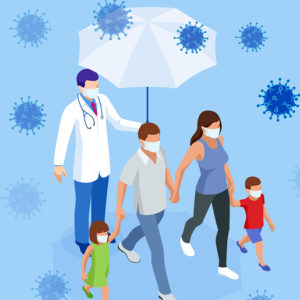WASHINGTON — The scene is deceptively tranquil: People cruising down near-empty streets on bicycles, young parents playing with their kids, joggers puffing along on sidewalks.
It’s just as it should be on a Sunday except that it’s a weekday when the main streets would ordinarily be crowded, the kids should be in school, and most normal people would be at work in busy offices to which they would have commuted on crowded subways and buses or in their own vehicles cursing as they wove in and out of traffic jams.
The headlines scream of an impending “Pearl Harbor” crisis, of between 100,000 and 200,000 dying, of hospitals and emergency rooms already filled, and doctors having to make life-or-death decisions as to whose life is worth trying to save with a precious ventilator and who might as well be left to die.
The visual contrast between the scenes around you and the realities of crowded hospitals and not enough ventilators and face masks, much less other more sophisticated equipment, is really beyond imagination.
In fact, you would never have imagined what’s happening all around you even in some fantastical film or novel full of strange turns and twists, but the drama is going on every day, every hour, in American cities, and no one dares predict with much certainty when or how the play will end.
A few weeks? By midsummer? By the end of the year? You hear forecasts from one extreme to the other, spoken tentatively, hesitantly, simply because no one knows.
Nor is there any telling where and how the disease will strike, but one danger is pretty clear. If you can’t spend all your waking and sleeping hours at home, as we are often reminded is the safest place of all, at least you can avoid crowds like the plague.
The most vulnerable are the aged and infirm consigned to nursing homes where cluster outbreaks have become the new normal. Even if the old folks have separate rooms, they’re often still too close to avoid transmission of the disease.
It was also way too crowded aboard the carrier Theodore Roosevelt, now at Guam getting cleaned up and sprayed down from stem to stern after dozens of sailors aboard the vessel picked up the bug in a joyous few hours on shore in the central Vietnamese port of Danang.
There’s a wondrous irony here.
It was in 1965 that the first wave of U.S. Marines went ashore at Danang, where they were greeted by the mayor and pretty girls with garlands of flowers at the outset of a war in which their mission was to defeat the forces of Vietnamese communism. It was a noble cause, American people were told, and it wouldn’t take long to show the enemy the evil error of its ways.
Thousands of Marines, and the U.S. Army troops who replaced them, lost their lives in a war that was probably not winnable unless the United States sent troops on the ground into the heart of the enemy above the 17th parallel.
That was the line that supposedly divided Vietnam in 1954 like the 38th parallel the Americans had scrawled on a map between the two Koreas in 1945. The Americans had gone home two years before the forces from the land we called “North” Vietnam swept south to victory over all “South” Vietnam 45 years ago this month.
This time, on a friendly port call, surrounded by a flotilla of supporting vessels, the Theodore Roosevelt encountered an enemy far more insidious, more powerful, more stubborn and enduring than the Vietnamese communists. Compounding the ravages of COVID-19 is the drama of the dismissal of the captain of the carrier for publicizing his feelings about the danger of the disease in a letter to his bosses.
Then, in the next act in the drama, came the denunciation of the captain by the acting secretary of the navy in an harangue to the sailors on the carrier, after which the acting secretary had to resign for his foul language.
Here in the U.S. capital, the drama of the Theodore Roosevelt was mostly a distraction, a sideshow among many others as men and women worried about when or whether they too would be snuffed by the disease, their careers ended, their high hopes dashed.
Even as the beautiful spring days faded into dark nights of uncertainty, Washington never looked so calm, so laid back, so peaceful while all-news stations blared out the numbers of dead and dying, ill and fearful, and the papers emblazoned the bad news in banner headlines over story after story.
Through it all was the image of the president, Donald Trump, holding forth before a skeptical media, trying to make up for his failure to anticipate the disaster engulfing the land that he had once pledged to make great again.

